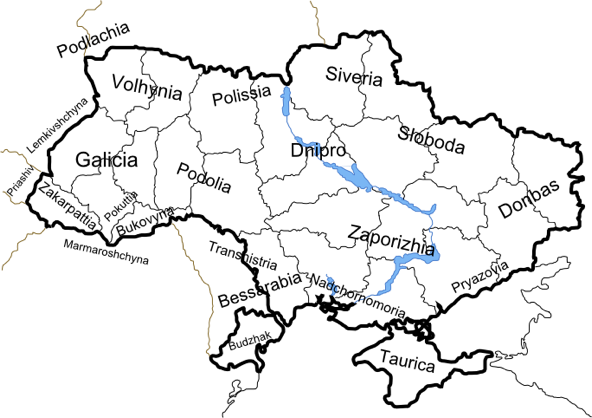Regional Pysanky

An Ethnographic Map of Ukraine from Ukrainian Folk Pysanka (Vira Manko)
Ukraine is divided in several ethnographic regions, differentiated from each other by dialect, traditions, costume, and design. The exact number of such regions, and their exact boundaries, is a matter of dispute amongst ethnographers. I have included several different ethnographic maps on these pages for purposes of comparison.
Although Ukrainians create the same sorts of handcrafts throughout the country, style and design motifs vary greatly. This especially true of pysanky. According to the Encyclopedia of Ukraine:
A great variety of ornamental patterns are found on pysanky. Because of the egg's fragility, no ancient examples of pysanky have survived. The oldest designs of Ukrainian ornamentation are known only because of the continuity of the ritualistic tradition of painting pysanky....
In the central regions of Ukraine vegetative motifs, stylized and geometrical (in the Kyiv region and Poltava region), the meander (bezkonechnyk), and the stylized rose, symbolizing the sun, have been dominant elements in pysanka designs. In the Chernihiv region (eastern Polissia) more naturalistic, asymmetrical, floral patterns have been widely used. Geometric ornamentation has been more prevalent in the western regions. Certain regions, however, such as the foothills of the Carpathian Mountains, have had their own, distinct ornamental patterns. In the Sokal vicinity floral ornamentation has been used in a florid manner. The designs and colors of the Boiko region have been more restrained: darker colors have been used near Drohobych and strongly contrasting colors near Kalush.
The pysanky of the Hutsuls are distinguished by their intricate designs and fine execution. In most, complex geometric ornamentation has dominated. Their strong and rich colors, color range, and combinations and complexity correspond to the ornamentation of the Hutsul wood carvings, metal art objects, and embroidery. The Hutsul region merits the name ‘land of the artists.’ It is not surprising that pysanka painting was most developed there.
Modern Ukraine is divided into oblasts (states/provinces), which are only vaguely based on the traditional ethnographic regions. Volyn, for example, is now split between six different oblasts––Volyn, Rivne, Zhytomyr, Lviv, Khmelnytskyi and Ternopil. In addition, several traditionally Ukrainian areas are now parts of Poland, Belarus, Slovakia, Russia, Moldova and Romania; some have been ethnically cleansed, some assimilated and others forcibly Russified.
On the following pages are traditional pysanky from many different regions of Ukraine. In a few cases, I have changed the colors or design slightly (often due to problems with dyeing), but I have tried to stick to original patterns as closely as possible (albeit with modern dyes and straighter lines).
Click on the links below to take you to the corresponding web pages. You can find most of the corresponding regions on the map above (taken from Vira Manko’s book), the map below, or (for extraterritorial ethnographic regions) the Ukrainian Arts map here. I have combined a few small regions and used the most commonly known names of regions.
I have also tried to use standard modern transliteration wherever possible (Manko’s book used a Polonized version, with the “j” having the sound of the consonant “y” in the first English edition; this has been corrected to standard transliteration in the second), but have sometimes included better known Anglicized (e.g. Galicia) names where available. My use of the softening apostrophe is a bit inconsistent–it is no longer required for standard transliteration by the Ukrainian government. I have begun deleting them, and no longer use them in new text, but vestiges may remain. And I’ve switched from using “ya” for the Я to the more standard “ia,”except at the beginning of words.
I have divided Ukraine into three major areas, based on geographic and historical considerations, with numerous smaller ethnographic regions within each:
Західне Полісся: Polissіa (western)
Сокаль: Sokal (a small area within Halychyna with very distinct decorative traditions)
Львівщина: Lviv region, i.e. Central Halychyna/Galicia (Includes Opillia and Roztochіa)
Підляшшя: Pidlіashіa/Podlachia, Kholm region
Надсяння: Nadsiannia, Peremyshl region
Поділля: Podillіa
Буковина: Bukovyna
Бойківщина: Boiko region
Гуцульщина: Hutsul region
Закарпаття: Zakarpattia/Transcarpathia
Лемківщина: Lemko region (including Priashiv)
Покуття: Pokuttia
Кубань: Kuban
Середнє Подніпров’я: Middle Dnipro (Dnieper) region
Київщина: Kyiv region
Полтавщина: Poltava region
Черкащина: Cherkasy region
Полісся Polissіa (eastern)
Чернігівщина: Chernihiv region
Причорномор’я/Приазов’я: Prychornomorіa/Pryazovіa (Black & Azov Sea regions)
Слобожанщина: Slobozhanshchyna/Sloboda

A different scheme of Ukrainian ethnographic regions (Anglicized names)
from Wikipedia
Back to Traditional Pysanky HOME
Back to MAIN Pysanka home page.
Back to Pysanka Index.
Search my site with Google

Kuban

